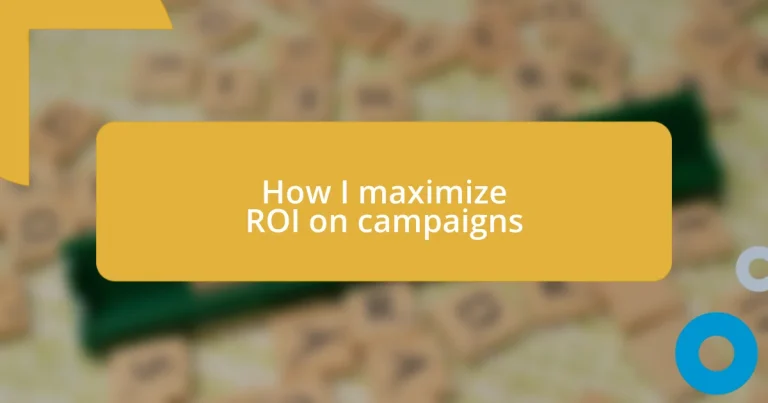Key takeaways:
- Understanding ROI is about interpreting data beyond numbers; focus on metrics that align with business goals and continuously optimize strategies.
- Setting clear, SMART goals and involving the team leads to improved campaign performance, motivation, and clearer benchmarks for success.
- Analyzing target audience insights through data and feedback is crucial for tailoring campaigns effectively and enhancing customer engagement.
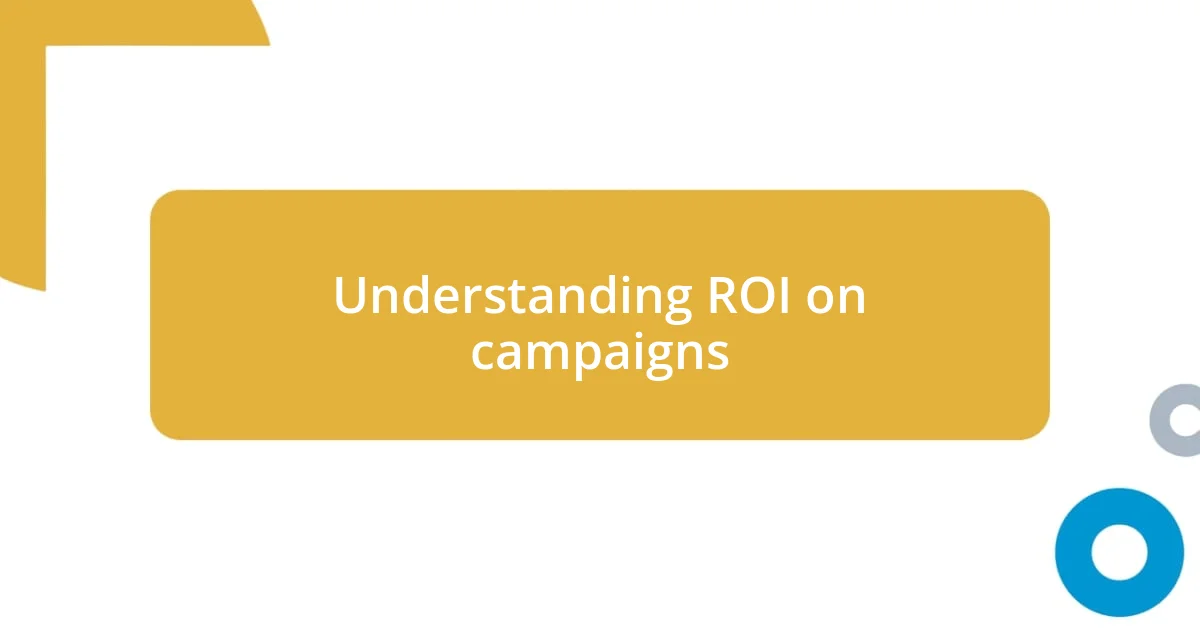
Understanding ROI on campaigns
Understanding ROI on campaigns requires more than just crunching numbers; it’s about interpreting those numbers to see what they truly mean for your business. I remember a time when a campaign I ran looked great on paper, but when I dived deeper, I discovered areas where we could optimize our spend. Have you ever felt that rush of excitement from high engagement metrics, only to find that conversions didn’t match? That frustration often leads to deeper insights.
At its core, ROI (Return on Investment) is about the efficiency of your spending and the effectiveness of your strategies. Sometimes, I find it helpful to break down ROI into tangible metrics that resonate with our brand goals. For instance, rather than just looking at the overall revenue generated, consider how many new customers were acquired and how many existing ones were retained. Isn’t it fascinating how small shifts in your approach can lead to significant improvements in your return?
Ultimately, understanding ROI is about continuous learning and iterating on your campaigns. I recall a project where we adjusted our messaging after analyzing our ROI; the results were astonishing! It’s this cycle of reflection and adaptation that truly elevates your marketing efforts. What lessons have you learned from your campaigns?
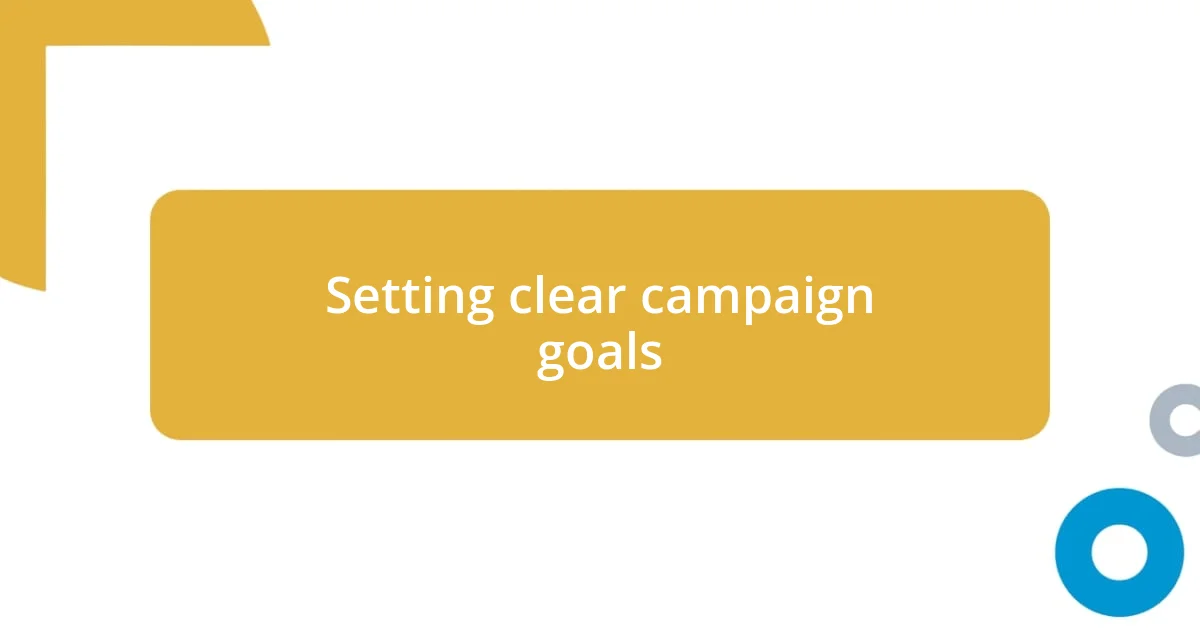
Setting clear campaign goals
Setting clear goals for your campaign is essential to maximizing ROI. In my experience, when I’ve taken the time to define precise, measurable objectives, the clarity truly transforms the execution phase. For instance, I once set a goal to increase email sign-ups by 30% within a quarter. This specific target not only fueled my team’s motivation but also provided a concrete benchmark to measure success against.
Here are some key points to consider when establishing your campaign goals:
- Make them SMART: Specific, Measurable, Achievable, Relevant, Time-bound. This framework helps ensure your goals are clear and realistic.
- Align with business objectives: Ensure your campaign goals support broader business strategies for cohesive growth.
- Involve your team: Collaborative goal setting promotes ownership and can reveal diverse insights.
- Set both short and long-term targets: This helps maintain momentum while keeping an eye on larger outcomes.
By focusing on these elements, I’ve seen a palpable difference in both campaign performance and team morale. There’s a distinct satisfaction that comes from hitting those milestones together.
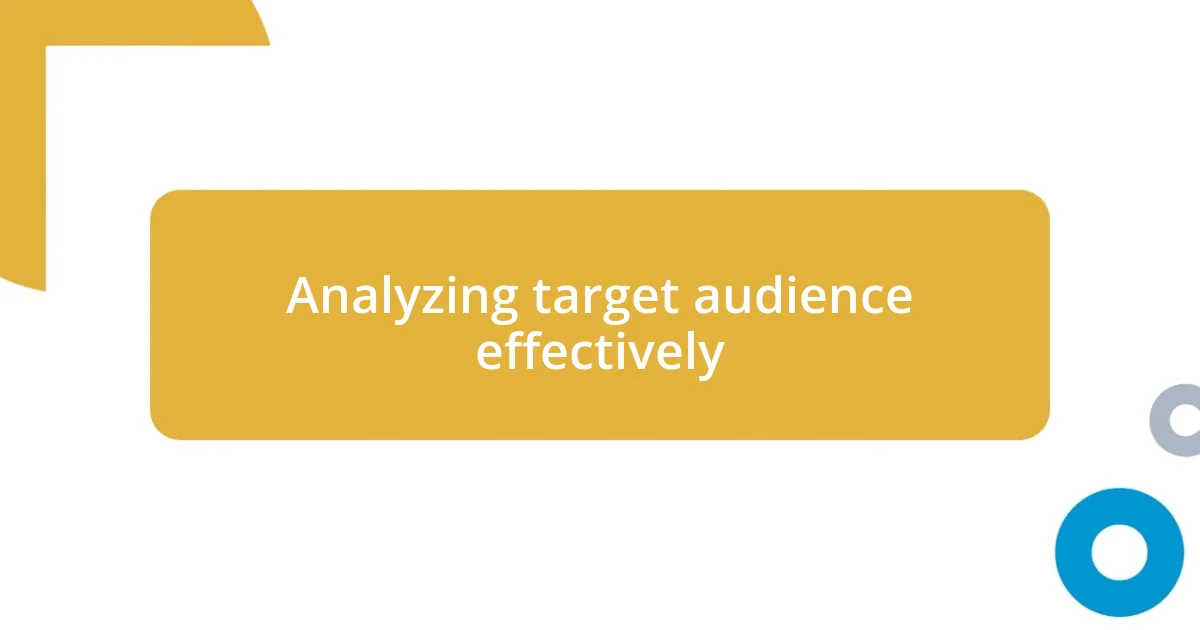
Analyzing target audience effectively
Analyzing your target audience is pivotal in crafting effective campaigns that drive ROI. I remember embarking on a campaign targeting a demographic I thought was ideal, only to discover later through audience analysis that I was missing the mark. This discovery not only shifted my perspective but also taught me the invaluable lesson of truly understanding who I’m marketing to. Have you ever found yourself surprised by the segments that resonate most with your message? It can be an eye-opener.
To effectively analyze your target audience, it’s important to leverage data and insights. Using tools like Google Analytics allows you to dive into who is engaging with your brand, providing a clearer picture of their demographics and interests. For example, I once analyzed the age groups interacting with our social media content and found that a younger audience was far more engaged than I anticipated. By adapting our campaign to this newfound insight, we tailored our messaging and saw a dramatic increase in engagement. It’s remarkable how these analytics can change the course of your strategy.
Don’t forget to combine qualitative data with quantitative insights. Surveys or direct interviews can provide emotional contexts and preferences that numbers alone can’t capture. I remember conducting a survey which revealed not just age and location, but also the values and aspirations of our audience. Uncovering these emotional connections allowed our campaign to resonate deeply, leading to increased customer loyalty. Hasn’t that emotional layer often given your campaigns that unique edge?
| Analysis Method | Benefits |
|---|---|
| Google Analytics | Provides demographic and behavior data, helping you understand engagement levels. |
| Surveys/Interviews | Gives insights into audience values and attitudes, facilitating deeper emotional connections. |
| Social Media Insights | Reveals audience interactions and preferences across platforms, guiding content strategy. |
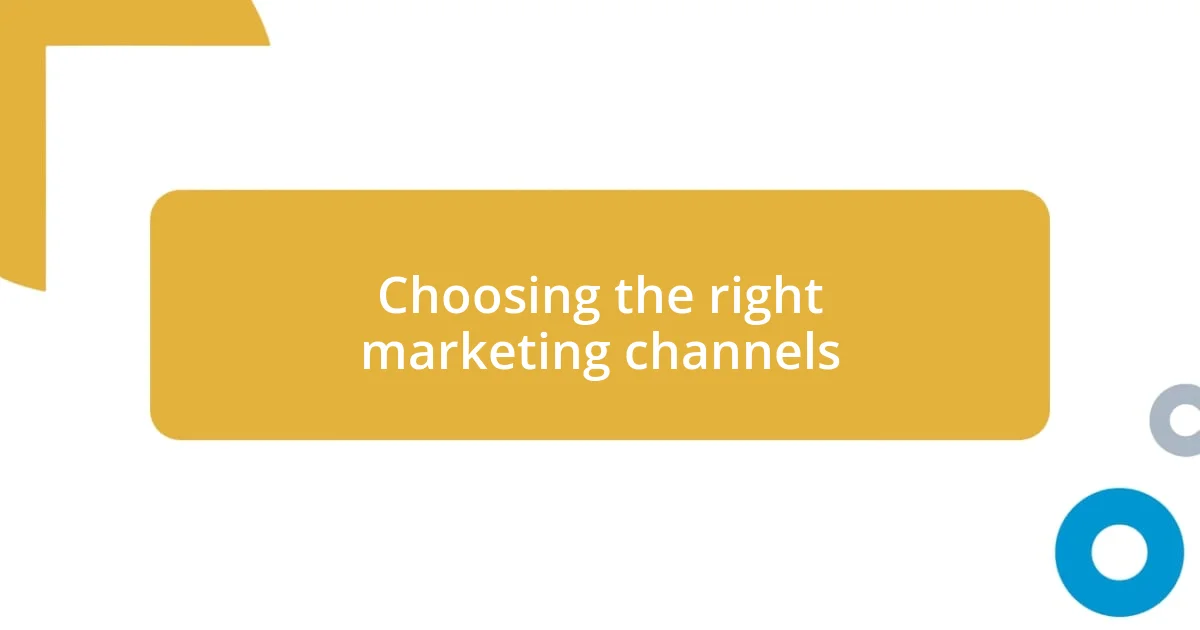
Choosing the right marketing channels
Choosing the right marketing channels can feel overwhelming, but I’ve discovered that it’s about understanding where your audience lives and where they actively engage. For example, I once spent a good amount of my budget on print advertising, thinking it would reach a broad audience. It wasn’t until I closely examined the analytics that I realized my target demographic was predominantly online. Have you ever committed resources to a channel only to feel the impact wasn’t there? It can be disheartening, but it highlights how critical it is to align your channel strategy with audience behavior.
I learned that combining both traditional and digital channels often yields the best results. There was a campaign where I decided to integrate email marketing with social media ads, targeting users who interacted with our content. The synergy created a ripple effect; those who engaged on platforms like Instagram were more likely to open our emails. This holistic approach not only maximized our reach but also significantly boosted conversion rates. How do you feel about the balance between different marketing channels?
When selecting channels, it’s essential to consider the unique characteristics of each. For instance, while visual platforms like Instagram might excel in brand storytelling, B2B efforts often thrive on LinkedIn due to its professional audience. I once pivoted a campaign focused on lead generation from Instagram to LinkedIn and saw transformations in engagement levels that I hadn’t anticipated. The lesson here is clear: don’t just choose channels based on trends—choose them based on fit and purpose.
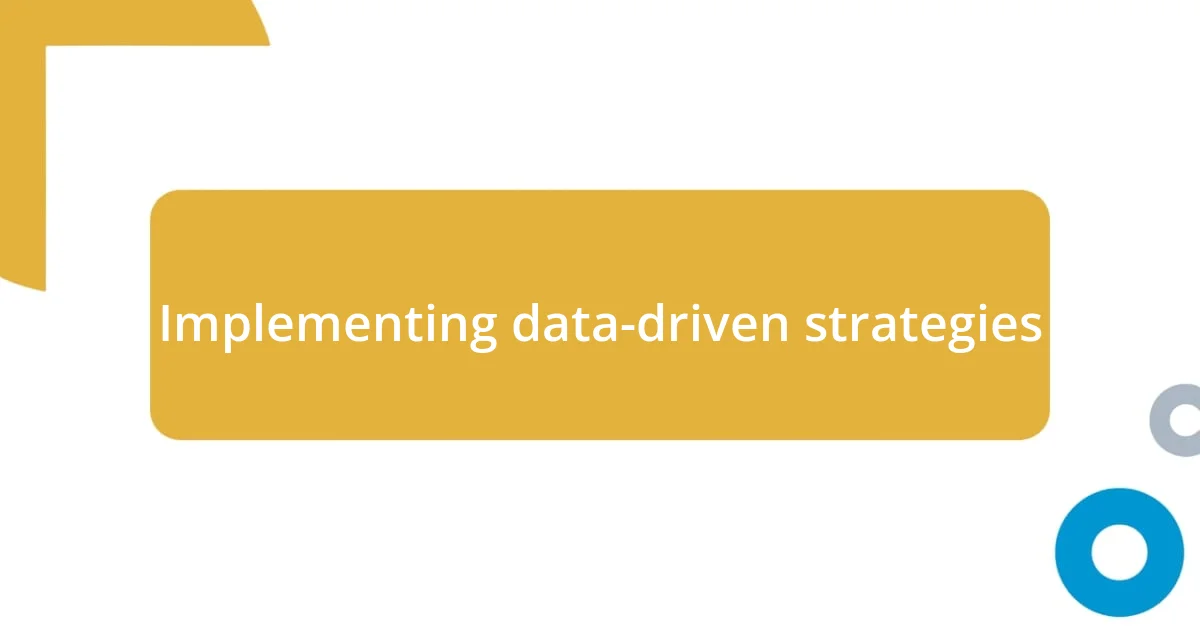
Implementing data-driven strategies
Implementing data-driven strategies truly transforms how I approach marketing campaigns. For me, one of the most impactful experiences was integrating customer relationship management (CRM) tools into our strategy. By analyzing customer interactions and feedback through these platforms, I was able to tailor our campaigns in ways I hadn’t imagined. Have you ever felt that sudden clarity when the data speaks to you? It’s almost like having a conversation with your audience.
One strategy I found particularly effective is running A/B tests on various campaign elements. I vividly remember a time when my team and I couldn’t decide between two email subject lines. After some careful testing, we discovered that one phrase outperformed the other by a staggering 30%. This not only optimized our open rates but also built an evidence-based approach that felt empowering. Have you tried A/B testing yet? It might just be the secret ingredient you’ve been missing!
Incorporating predictive analytics has also changed my outlook. By analyzing historical data, I can forecast trends and consumer behavior with greater accuracy. Last year, we used these insights to prepare for seasonal demands, which led to a 25% increase in sales during a typically slow period. It’s fascinating how numbers can not only inform but also guide your decisions in proactive ways. What tools have you found helpful in predicting your campaign outcomes? Your insights could be the key to unlocking even greater returns.
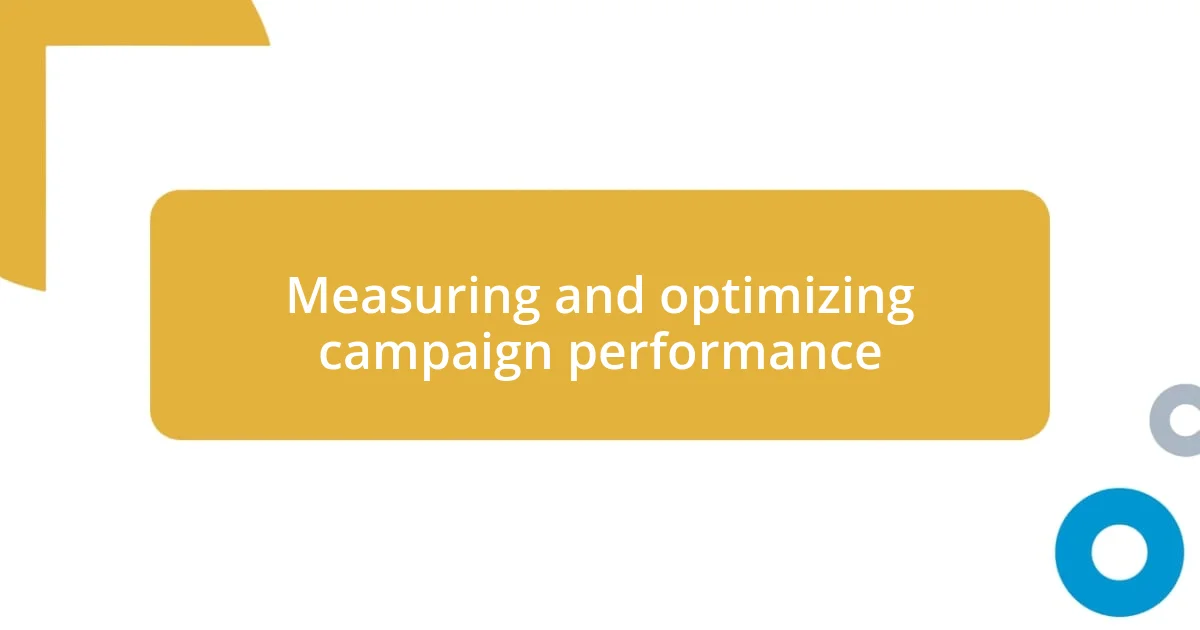
Measuring and optimizing campaign performance
Measuring campaign performance goes beyond just looking at numbers—it’s about interpreting what those numbers mean for your strategy. One time, I noticed a drop in our click-through rates that initially felt alarming, but when I delved deeper, I realized it correlated with changes in audience interests. Have you ever unearthed a surprising insight that completely redefined your approach? It really emphasizes the importance of looking beneath the surface.
To optimize performance, I use analytics dashboards to track various metrics like engagement, conversions, and customer feedback continuously. During one campaign, I set up real-time alerts for key performance indicators (KPIs), which allowed me to pivot our messaging within hours instead of waiting for a weekly report. This responsiveness felt exhilarating, as it turned what could have been a failing effort into a thriving one. How quickly can you pivot your strategy when faced with unforeseen results?
Feedback loops are essential in my process for refining campaigns. I often gather input from my team and even directly from customers to understand what resonates. For example, after a particularly successful ad, I reached out to a few engaged customers, and their insights helped me craft follow-up campaigns that hit the mark even more precisely. Have you tapped into your community’s knowledge lately? Trust me, the perspectives you gain can significantly enhance your campaign effectiveness.
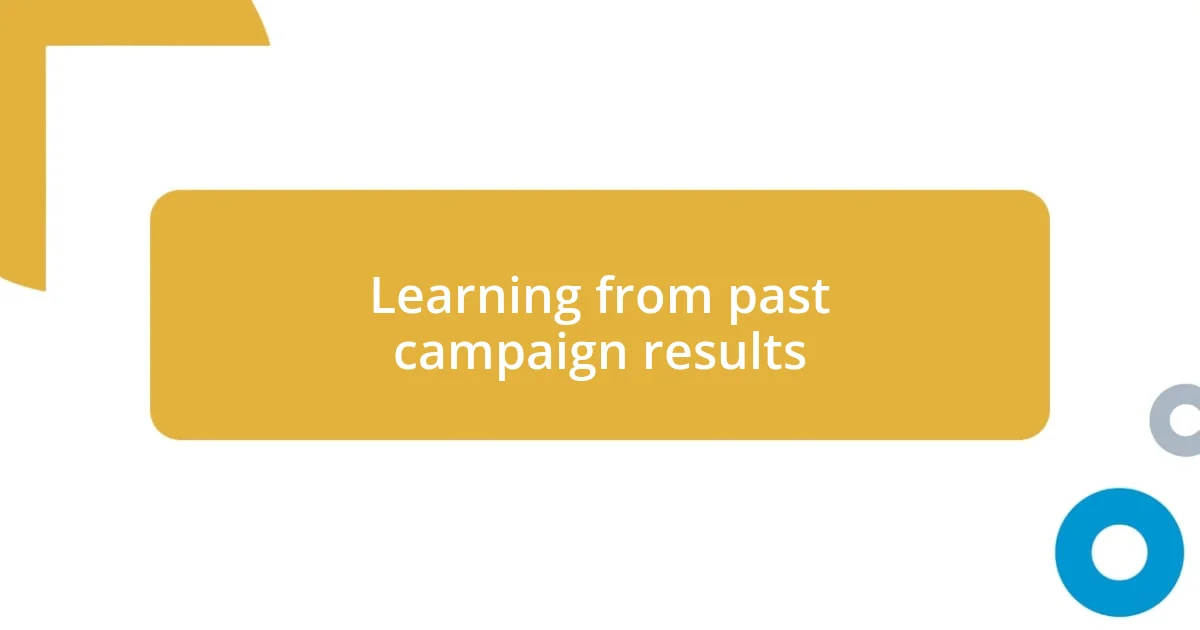
Learning from past campaign results
Learning from past campaign results is a powerful way to sharpen our strategies for future endeavors. One memorable campaign taught me the value of post-analysis discussions with my team. After a campaign that didn’t perform as expected, we gathered for a brainstorming session. It was enlightening to hear different perspectives and identified areas where we missed the mark. Have you ever reflected openly with your team about what went wrong? It transforms failures into stepping stones for success.
Data can feel overwhelming, but breaking down past performance into digestible parts helps immensely. I once created a simple chart comparing the ROI of several campaigns. The visual helped me see patterns I had missed; for instance, our video campaigns consistently outperformed static ads. Recognizing this trend motivated me to prioritize video content moving forward. Isn’t it incredible how a little visualization can spark a monumental change in strategy?
Moreover, revisiting client feedback helped me fine-tune our messaging. I distinctly remember encountering a client’s comment about our campaign being “too generic.” That stuck with me! It led to a more tailored approach in future campaigns, crafting messages that felt more personal and relevant. Have you considered the voices of your audience in your analysis? By listening, we not only learn but also build stronger connections that resonate with our target market.












